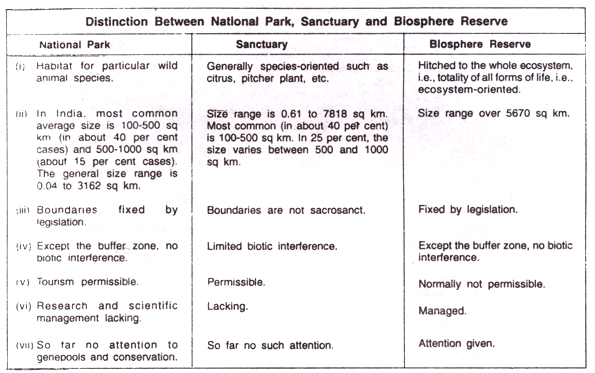Protected Areas
- In simplest terms, Protected Areas are regions or zones of land or sea which are given certain levels of protection for conservation of biodiversity and socio-environmental values. In these areas, human intervention and exploitation of resources are limited.
- Protected Areas are the principal mechanism of conservation of biodiversity on Earth and serve as the most important units for in-situ biodiversity conservation.
- In India, there are four major categories of Protected areas. These protected areas are constituted under the provisions of the Wildlife (Protection) Act, 1972.
- The four categories of protected areas are:
- Wildlife Sanctuaries
- National Parks
- Community Reserves
- Conservation Reserves
- Apart from these protected areas, India also has the following:
- Biodiversity Reserves
- Tiger Reserves
- Elephant Reserves
- Marine Protected Areas
- Forests and wildlife are included in the Concurrent List of the Indian Constitution. Therefore, the Union government makes the policies and plans for Wildlife Conservation. On the other hand, the State Forest Departments are the ones implanting those national policies and plans at the state level.
- National Board for Wildlife (NBWL) puts forward a policy framework for wildlife conservation in India. The Board was constituted under Wildlife (Protection) Act, 1972. It is chaired by the Prime Minister.
- National Board for Wildlife:
- It is a “Statutory Organization” constituted under the Wildlife Protection Act, 1972.
- Its role is “advisory” in nature and advises the Central Government on framing policies and measures for the conservation of wildlife in the country.
- The primary function of the Board is to promote the conservation and development of wildlife and forests.
- It has the power to review all wildlife-related matters and approve projects in and around national parks and sanctuaries.
- No alternation of boundaries in national parks and wildlife sanctuaries can be done without the approval of the NBWL.
- Composition: The NBWL is chaired by the Prime Minister. It has 47 members including the Prime Minister. Among these, 19 members are ex-officio members. Other members include three Members of Parliament (two from Lok Sabha and one from Rajya Sabha), five NGOs, and 10 eminent ecologists, conservationists, and environmentalists.
- National Board for Wildlife may make recommendations on the setting up of and management of national parks, sanctuaries, and other protected areas and on matters relating to restriction of activities in those areas.
- The State Board for Wildlife shall advise the State government on the selection and management of areas to be declared as protected areas.
- National Board for Wildlife:
- Wildlife Protection Act, 1972 (with Amendment Acts of 2003 and 2006)
- It provides for the protection of plants and animals in India. The aim of the Act is to ensure the ecological and environmental security of India.
- It is the principal act that contains provisions for setting up and managing national parks, sanctuaries, and other protected areas.
Protected Areas of India (As of Jan 2023)
| Protected Areas | No. | Coverage % of Country |
|---|---|---|
| National Parks (NPs) | 106 | 1.35 |
| Wildlife Sanctuaries (WLSs) | 567 | 3.73 |
| Conservation Reserves (CRs) | 105 | 0.16 |
| Community Reserves | 220 | 0.04 |
| Total Protected Areas (PAs) | 998 | 5.28 |
- As of Jan 2023, there were 998 notified protected areas covering 5.28% of India’s land area. This is far below Target 11 of the Aichi Targets – which states that by 2020, at least 17% of terrestrial and inland water areas should be conserved under Protected Areas.
- There are several kinds of protected areas, which vary by level of protection. Examples include national parks, wildlife sanctuaries, marine protected areas, community reserves, etc.
In terms of protection, National Parks > Wildlife Sanctuary > Reserved forests > Protected forests
Different IUCN categories of Protected areas
- The International Union for Conservation of Nature (IUCN), through its World Commission on Protected Areas, has put forward Six Protected Area Management Categories. The categories are as follows:
- Category I a– Strict Nature Reserve: Protected areas managed mainly for science and receives the least human intervention. E.g. Urwald Rothwald in Austria
- Category I b – Wilderness Area: Wilderness protection. E.g. wilderness areas in the Sami native region in Finland
- Category II – National Park: ecosystem protection and recreation
- Category III – Natural Monument or Feature: Conservation of specific natural features. E.g. cliffs, caves, forest groves. E.g. Cono de Arita in Argentina.
- Category IV – Habitat/Species Management Area: Conservation of specific species that require protection.
- Category V – Protected Landscape/Seascape: Conservation of entire area. It permits the surrounding community to interact. Example: Great Barrier Reef in Australia
- Category VI – Protected Area with sustainable use of natural resources: Conservation of ecosystem and habitats together with associated cultural values and traditional natural resource management systems.

